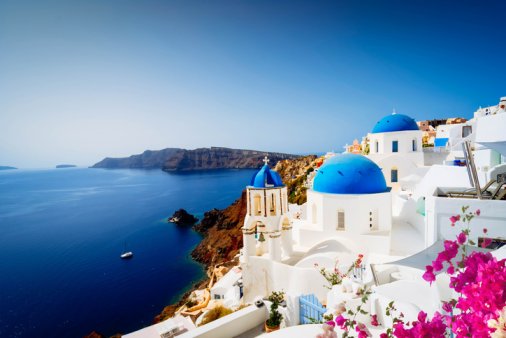Your Ultimate Guide to Summer in Italy: Best Time to Visit, Places to Go, What to Wear, and Travel Tips
Discover the perfect time to visit Italy in summer, from pleasant early summer to the tranquility of late September. Explore famous destinations, essential clothing for the warm weather, and must-do's to make the most of your Italian summer adventure. Get travel tips, FAQs, and everything you need to know for your unforgettable trip to Italy.
An Italian Summer Guide
- Best time to visit: Early summer (May-June) is pleasant with fewer crowds.
- September is also good with warm weather and fewer crowds. July and August are the hottest and most crowded.
- Discover famous destinations, what to wear, and the best time to visit.
With the land bathed in the warm glow of the Mediterranean sun - a summer in Italy is a feast for the senses. Beyond the grandeur of Rome's Colosseum and the charming canals of Venice - Italy is more than just sights.
It's the warmth of its people, the passion in their voices, and the pure joy of savoring a delicious plate of pasta under a starlit sky. But, where should you start from?
This ultimate guide covers everything you need to know for the best summer trip to Italy.
Best Time to Visit Italy in the Summer Season
Wondering - how hot is Italy in the summer? Summer season in Italy stretches from May to September, and the intensity of heat can vary depending on the month and location. So the perfect time for your visit depends on what you want to prioritize.
Early Summer (May-June)
Early summer is a delightful time to visit the country. Days are pleasantly warm with average highs around 82°F, while evenings remain cool with lows near 64°F. You can expect mostly sunny weather with the occasional refreshing rain shower.
Moreover, the landscapes are lush and vibrant, making them perfect for outdoor activities like hiking or cycling through the countryside. You may also enjoy comfortable weather for sightseeing in cities without the peak season crowds, and often find better prices on flights and accommodations as well.
Mid-Summer (July-August)
July and August mark the hottest months of the summer season, with average highs near 86°F and lows around a comfortable 68°F. At this time, there'll be glorious sunshine, clear skies, and minimal rain – ideal for soaking up the sun on stunning beaches.
Cities might feel hotter, but coastal areas and lakes offer refreshing places to escape the heat. Keep in mind this peak season means larger crowds and more prices for accommodation and travel.
Late Summer (September)
September, potentially the best month to travel to Italy as it offers a beautiful transition as peak summer winds down. The temperatures remain pleasantly warm with average highs around 80°F and comfortable lows near 64°F.
In late Summers, the crowds start to thin out, creating a more relaxed atmosphere for sightseeing and exploring Italy's treasures. It is also the harvest season, so if you are in the Italian countryside, you might get to enjoy local food festivals that celebrate wine, fresh produce, and regional traditions.
Note: For a refreshing escape, consider exploring the mountainous regions of northern Italy to enjoy cooler weather at any point during the summer.
The Best Places to Visit in Italy During Summers
Italy truly comes alive in the summer, with vibrant cities, stunning beaches, and charming countryside. So here are some of the most popular places to visit in Italy in summer.
Northern Italy
Northern Italy is a great summer destination with mountains, lakes, and historic cities. If you love hiking and are trying to find things to do in Italy, the Dolomites, a UNESCO World Heritage Site, offer gorgeous trails, clear lakes, and quaint villages.
For a luxurious lakeside escape under the sun, visit Lake Como and explore charming towns like Bellagio, admire elegant villas, or take a scenic boat tour. The larger Lake Garda provides a livelier atmosphere with watersports and family attractions.
You can also experience the utterly unique charm of Venice, the City of Canals; take a gondola ride, wander through St. Mark's Square, and marvel at the Doge's Palace. Remember, Venice now charges a tourist entry fee to help manage crowd control and preserve the city.
The blissful beauty of the Cinque Terre villages truly comes alive under the summer sun. You might love hiking between the villages along dramatic cliffs overlooking the sparkling Mediterranean Sea.
Central Italy
Central Italy basks in sunshine and warm temperatures, ideal for sightseeing, relaxing outdoors, and enjoying long, balmy evenings. In Rome, the Eternal City, you may love to explore ancient ruins like the Colosseum and visit the iconic Trevi Fountain.
Tuscany enjoys warm, sunny days and cool nights in the summer, making it perfect for exploring the region's many outdoor attractions. You can spend hours wandering through the charming piazzas and streets without getting too hot.
The city of Florence is known for artistic masterpieces like Michelangelo's David, the Uffizi Gallery, and the impressive Duomo Cathedral. But also, be sure to see Pisa’s famous Leaning Tower.
If you are lucky, you may get the chance to experience the thrilling Palio horse race, held in Siena, twice a year during the summer months.
Southern Italy
With little rain, southern Italy is ideal for enjoying outdoor activities and soaking up the sun on pristine beaches. The region also offers the best of both - sunny days and warm Mediterranean evenings.
The Amalfi Coast has scenic towns built into the cliffs. Here, you may swim in the clear waters, explore the towns on foot or take a boat trip along the coast. Similarly, Capri is a small island off the coast of Southern Italy that is known for its beautiful scenery. The Blue Grotto is a natural cave that is only accessible by boat and is a must-visit site in Capri.
The ancient Roman city of Pompeii which was buried by the eruption of Mount Vesuvius is another site not to be missed. There are plenty of historical sites to see in Naples, as well as lively markets and delicious food.
Sicily, the largest Mediterranean island, is quite a happening spot with active volcanoes, beautiful beaches, and ancient Greek ruins. Finally, Sardinia and Puglia will be great to relax and enjoy the slow pace of life in Southern Italy in the summer months.
Pro tip: To ensure a smooth traveling experience in European countries, consider the Schengen travel protection plan . Make sure to double-check your passport to avoid any issues during the trip.
What to Wear in Italy in Summer?
Summer months in Italy are warm and sunny, so you must pack accordingly. Here’s a list of essential outfits to help you pack for your summer trip to Italy.
Essential Clothing for Italy
- Shirts: Choose lightweight, breathable fabrics like cotton or linen. T-shirts, tank tops, and short-sleeved blouses are great outfits for Italy in summer.
- Bottoms: Comfortable shorts, skirts, or capri pants are ideal for exploring. Opt for loose-fitting styles in light colors.
- Dresses: Pack a few airy, flowy dresses for both day and evening wear.
- Footwear: Focus on comfortable walking shoes like sneakers or sandals. Bring a dressier pair of sandals for dinners out.
Also Consider:
- Cover-up: A long-sleeved shirt or lightweight sweater is useful for cooler evenings or air-conditioned buildings. You may also get a lightweight scarf for protection from the sun.
- Swimwear: Pack a swimsuit and cover-up for beach or pool time.
- Sun Protection: A wide-brimmed hat and goggles are important for shielding yourself from the sunshine. Also, keep some hats to wear in Italy’s summer and enjoy your trip in style.
What not to wear in Italy in summer?
When visiting churches or religious sites, it’s important to dress respectfully despite the heat. You may go for knee-length or slightly longer bottoms, plus shirts with sleeves that cover your shoulders.
Places to Stay in Italy
There are many accommodation options available to suit your traveling style and budget in this European country. Here’s what you can consider:
- Choose from many housing choices available, including luxury hotels, charming bed and breakfasts, and traditional villas. These are often found in cities and popular resort areas.
- Consider staying within walking distance of major attractions, museums, and vibrant city life, but be prepared for potential crowds and higher prices.
- If you're looking for a unique experience, staying in a converted farmhouse provides a unique rural experience, sometimes including home-cooked meals and a chance to connect with Italian countryside life.
Must-Do's To Make the Most of Your Summers in Italy
Among most European destinations, Italy basks in the summer sun, making it a prime destination for tourists. Here’s what you must do to ensure a memorable stay.
Make Advance Bookings
Among most European destinations, Italy basks in the summer sun, making it a prime destination for tourists. This popularity, however, means peak season rush and therefore the need to plan ahead.
So, if you plan to travel to Italy from US, especially in July and August - book your flights and accommodations as early as possible. This will help you avail the best prices and avoid limited availability.
Tickets for major museums and landmarks like the Colosseum, Vatican Museums, Uffizi Gallery, Leaning Tower of Pisa, etc., can also sell out quickly. Booking online in advance (typically 2-3 months) can help you skip long lines.
Protect Your Summer Vacation in Italy
Consider travel insurance to protect your Italian vacation against unexpected situations like trip cancellations, medical emergencies, or lost luggage. Compare different AXA Travel Protection Plans and choose the right coverage limits that meet your needs.
You may also look for features like " Cancel for Any Reason " for protection even if you need to cancel for unforeseen personal circumstances. Meanwhile, medical expense coverage can be great for seniors, as general health insurance or Medicare might not be applicable in Italy.
Learn Some Basic Italian
A bonus tip for spending a smooth summer in Italy - learn a few greetings like "Buongiorno" (good morning), "Grazie" (thank you), and "Scusi" (excuse me). Plus, knowing "Dov'è...?" (where is...?) can be a lifesaver when navigating charming Italian streets.
FAQs
1. How long is a flight to Italy?
The flight time depends on the city where you depart. To travel to Italy from the US, flights tend to be shorter if you depart from the East Coast, taking around 8-9 hours. Fights from the West Coast could take 12-14 hours.
2. What currency does Italy use?
Italy uses the euro (€) as its currency.
3. What is the weather like in Italy?
Italy has a primarily Mediterranean climate, characterized by warm, dry summers and mild, wetter winters.
4. Do I need a visa to travel to Italy?
As a US resident, if your trip is for tourism or business purposes and lasts less than 90 days within a 180-day period, you're good to go without a visa.
5. Is it crowded in Italy during summer?
Yes, especially in popular tourist destinations and beach areas. Early summer and September tend to be less crowded.
6. What language is spoken in Italy?
Italian is the official language. English is spoken in some tourist areas, but basic Italian phrases are helpful.
7. What are some things to consider when budgeting for a summer trip to Italy?
Flights, accommodation, food, transportation, activities, and entrance fees. Prices tend to be more elevated during peak season.
8. What kind of food is popular in Italy during summer?
Fresh, seasonal ingredients like seafood, fruits, and vegetables are prominent. Popular summer dishes include pasta with Vongole (clams), gelato, and Caprese salads.
9. Are there any dietary restrictions I should be aware of when dining in Italy?
Vegetarian and vegan options can be limited. Many dishes are cheese or meat-based. Research restaurants beforehand if you have dietary restrictions.
10. How do I get around Italy?
Trains are a suitable and efficient way to travel between major cities. Buses and rental cars offer more flexibility for exploring smaller towns and the countryside.
Also Read: Italy, Is it safe: Italy, Travel Requirements: Italy

Get AXA Travel Insurance and travel worry free!
Travel Assistance Wherever, Whenever
Speak with one of our licensed representatives or our 24/7 multilingual insurance advisors to find the coverage you need for your next trip Get an instant quote!




